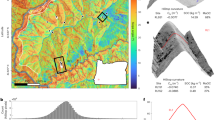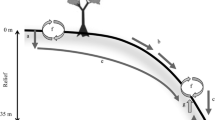Abstract
We quantified variation in plant nutrient concentrations and provenance along catenas in landscapes of three different ages (0.15, 1.4, and 4.1 ma) in the Hawaiian Islands. Strontium (Sr) isotopes demonstrate that erosion provides a renewed source of rock-derived nutrients to slopes in landscapes of all ages, in some cases reversing a million years of ecosystem development in a distance of 100 m. However the effects of this input vary with landscape age. Plants on uneroded surfaces in a 0.15-ma landscape derive ~20% of their Sr from local bedrock (foliar 87Sr/86Sr~0.7085), while on adjacent slopes this increases to ~80% (foliar 87Sr/86Sr~0.7045). Despite this shift in provenance, foliar N and P do not vary systematically with slope position. Conversely, eroded slopes in a 4.1-ma landscape show smaller increases in rock-derived cations relative to stable uplands (foliar 87Sr/86Sr~0.7075 vs 0.7090), but have >50% higher foliar N and P. These results demonstrate both that erosion can greatly increase nutrient availability in older landscapes, and that the ecological effects of erosion vary with landscape age. In addition, there can be as much biogeochemical variation on fine spatial scales in eroding landscapes as there is across millions of years of ecosystem development on stable surfaces.






Similar content being viewed by others
References
Basnet K (1992) Effect of topography on the pattern of trees in Tabonuco (Dacryodes-Excelsa) dominated rain-forest of Puerto Rico. Biotropica 24:31–42
Binkley D, Matson P (1983) Ion-exchange resin bag method for assessing forest soil-nitrogen availability. Soil Sci Soc Am J 47:1050–1052
Blum JD, Klaue A, Nezat CA, Driscoll CT, Johnson CE, Siccama TG, Eagar C, Fahey TJ, Likens GE (2002) Mycorrhizal weathering of apatite as an important calcium source in base-poor forest ecosystems. Nature 417:729–731
Capo RC, Stewart BW, Chadwick OA (1998) Strontium isotopes as tracers of ecosystem processes: theory and methods. Geoderma 82:197–225
Chadwick OA, Derry LA, Vitousek PM, Huebert BJ, Hedin LO (1999) Changing sources of nutrients during four million years of ecosystem development. Nature 397:491–497
Chen ZS, Hsieh CF, Jiang FY, Hsieh TH, Sun IF (1997) Relations of soil properties to topography and vegetation in a subtropical rain forest in southern Taiwan. Plant Ecol 132:229–241
Clague DA, Dalrymple GB (1987) The Hawaiian-Emperor volcanic chain: geologic evolution. In: Decker RW, Wright TL, Stauffer PH (eds) Volcanism in Hawaii. United States Geological Survey, Washington, D.C., pp 3–57
Clark D, Palmer M, Clark D (1999) Edaphic factors and the landscape-scale distributions of tropical rain forest trees. Ecology 80:2662–2675
Condit R, Ashton PS, Baker P, Bunyavejchewin S, Gunatilleke S, Gunatilleke N, Hubbell SP, Foster RB, Itoh A, LaFrankie JV, Lee HS, Losos E, Manokaran N, Sukumar R, Yamakura T (2000) Spatial patterns in the distribution of tropical tree species. Science 288:1414–1418
Crews TE, Kitayama K, Fownes JH, Riley RH, Herbert DA, Mueller-Dombois D, Vitousek PM (1995) Changes in soil-phosphorus fractions and ecosystem dynamics across a long chronosequence in Hawaii. Ecology 76:1407–1424
Frizano J, Johnson AH, Vann DR, Scatena FN (2002) Soil phosphorus fractionation during forest development on landslide scars in the Luquillo Mountains, Puerto Rico. Biotropica 34:17–26
Garten CT, van Miegroet H (1994) Relationships between soil-nitrogen dynamics and natural N-15 abundance in plant foliage from Great Smoky Mountains National Park. Can J For Res 24:1636–1645
Gartlan JS, Newbery DM, Thomas DW, Waterman PG (1986) The influence of topography and soil-phosphorus on the vegetation of Korup Forest Reserve, Cameroun. Vegetatio 65:131–148
Giambelluca TW, Nullet MA, Schroeder TA (1986) Rainfall atlas of Hawaii. Department of Land and Natural Resources, State of Hawaii
Giblin AE, Nadelhoffer KJ, Shaver GR, Laundre JA, McKerrow AJ (1991) Biogeochemical diversity along a riverside toposequence in arctic Alaska. Ecol Monogr 61:415–435
Gorham E (1961) Factors influencing the supply of major ions to inland waters, with special reference to the atmosphere. Geol Soc Am Bull 72:795–840
Graustein WC (1989) 87Sr/86Sr ratios measure the sources and flow of strontium in terrestrial ecosystems. In: Rundel PW, Ehleringer J, Nagy KA (eds) Stable isotopes in ecological research. Springer, Berlin Heidelberg New York, pp 491–511
Hirobe M, Tokuchi N, Iwatsubo G (1998) Spatial variability of soil nitrogen transformation patterns along a forest slope in a Cryptomeria japonica D. Don plantation. Eur J Soil Biol 34:123–131
Hook P, Burke I (2000) Biogeochemistry in a shortgrass landscape: control by topography, soil texture, and microclimate. Ecology 81:2686–2703
Jenny H (1941) Factors of soil formation. McGraw Hill, New York
Jenny H (1980) The soil resource: origin and behavior. Springer, Berlin Heidelberg New York
Kennedy MJ, Chadwick OA, Vitousek PM, Derry LA, Hendricks DM (1998) Changing sources of base cations during ecosystem development, Hawaiian Islands. Geology 26:1015–1018
Kuo S (1996) Phosphorus. In: Sparks DL, Page AL, Helmke PA, Loeppert RHS, Tabatabai MA, Johnston CT, Sumner ME (eds) Methods of soil analysis. Part 3: chemical methods. Soil Science Society of America, Madison, Wis., pp 898–899
Kurtz AC, Derry LA, Chadwick OA (2001) Accretion of Asian dust to Hawaiian soils: isotopic; elemental; and mineral mass balances. Geochim Cosmochim Acta 65:1971–1983
MacDonald GA, Abbot AT, Peterson FL (1983) Volcanoes in the sea: the Geology of Hawaii. University of Hawaii Press, Honolulu
Oliveira-Filho A, Vilela E, Carvalho D, Gavilanes M (1994) Effects of soils and topography on the distribution of tree species in a tropical riverine forest in south-eastern Brazil. J Trop Ecol 10:483–508
Poszwa A, Dambrine E, Pollier B, Atteia O (2000) A comparison between Ca and Sr cycling in forest ecosystems. Plant Soil 225(1–2):299–310
Raghubanshi AS (1992) Effect of topography on selected soil properties and nitrogen mineralization in a dry tropical forest. Soil Biol Biochem 24:145–150
Scatena FN, Lugo AE (1995) Geomorphology, disturbance, and the soil and vegetation of two subtropical wet steepland watersheds of Puerto Rico. Geomorphology 13:199–213
Schimel D, Stillwell MA, Woodmansee RG (1985) Biogeochemistry of C, N, and P in a soil catena of the shortgrass steppe. Ecology 66:276–282
Silver WL, Scatena FN, Johnson AH, Siccama TG, Sanchez MJ (1994) Nutrient availability in a montane wet tropical forest: spatial patterns and methodological considerations. Plant Soil 164:129–145
Stewart BW, Capo RC, Chadwick OA (1998) Quantitative strontium isotope models for weathering, pedogenesis and biogeochemical cycling. Geoderma 82:173–195
Takyu M, Aiba S, Kitayama K (2002) Effects of topography on tropical lower montane forests under different geological conditions on Mount Kinabalu, Borneo. Plant Ecol 159:35–49
Vitousek PM (2004) Nutrient cycling and limitation: Hawai’i as a model system. Princeton University Press, Princeton, N.J.
Vitousek PM, Farrington H (1997) Nutrient limitation and soil development: experimental test of a biogeochemical theory. Biogeochemistry 37:63–75
Vitousek PM, Turner DR, Kitayama K (1995) Foliar nutrients during long-term soil development in Hawaiian montane rain-forest. Ecology 76:712–720
Vitousek P, Chadwick O, Matson P, Allison S, Derry L, Kettley L, Luers A, Mecking E, Monastra V, Porder S (2003) Erosion and the rejuvenation of weathering-derived nutrient supply in an old tropical landscape. Ecosystems 6:762–772
Walker TW, Syers JK (1976) Fate of phosphorus during pedogenesis. Geoderma 15:1–19
Walker LR, Zarin DJ, Fetcher N, Myster RW, Johnson AH (1996) Ecosystem development and plant succession on landslides in the Caribbean. Biotropica 28:566–576
Whipkey CE, Capo RC, Chadwick OA, Stewart BW (2000) The importance of sea spray to the cation budget of a coastal Hawaiian soil: a strontium isotope approach. Chem Geol 168:37–48
Wolfe EW, Morris J (1996) Geologic map of the island of Hawaii. United States Geological Survey, Washington, D.C.
Wright TL, Clague DA (1989) Petrology of Hawaiian lava. In: Winterer EL, Hussong DM, Decker RW (eds) The Eastern Pacific Ocean and Hawaii. The Geological Society of America, Boulder, Colo., p 563
Acknowledgements
We thank the Joseph Souza Center and the State Parks and Forestry and Wildlife Divisions of the Hawaii Department of Land and Natural Resources for access to field sites and logistical support; Heraldo Farrington for assistance in the field; and Douglas Turner for assistance with laboratory analyses. Tom Bullen, John Fitzpatrick, and Joe Wooden assisted with Sr isotope analysis. This research was supported by a Stanford Graduate Fellowhip to S.P., and a grant from the Andrew W. Mellon Foundation.
Author information
Authors and Affiliations
Corresponding author
Rights and permissions
About this article
Cite this article
Porder, S., Paytan, A. & Vitousek, P.M. Erosion and landscape development affect plant nutrient status in the Hawaiian Islands. Oecologia 142, 440–449 (2005). https://doi.org/10.1007/s00442-004-1743-8
Received:
Accepted:
Published:
Issue Date:
DOI: https://doi.org/10.1007/s00442-004-1743-8




